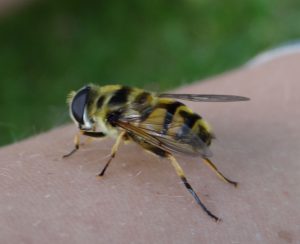Bee and Wasp Sting Treatments
 Being stung by a bee or a wasp, no matter where on your body it is can be a very unpleasant experience. But for some, it can be dangerous or even life-threatening. Below we’ve listed how to work out what level of reaction a sting has caused, along with a few bee and wasp sting treatments.
Being stung by a bee or a wasp, no matter where on your body it is can be a very unpleasant experience. But for some, it can be dangerous or even life-threatening. Below we’ve listed how to work out what level of reaction a sting has caused, along with a few bee and wasp sting treatments.
Severity of Reaction
Normal local reaction to a sting
This is the most common and least severe type of sting reaction. It usually contains a white spot (where the stinger pierced the skin), with a red 1-2cm ring around the sting.
Despite being small, the sting can be painful and under most circumstances can be treated at home. The pain will begin to subside after a couple of hours.
Large local reaction
Increasingly severe, a large local reaction usually means that a person will have more pronounced side effects. The swelling around the sting site usually increases for two to three days after the sting and people will begin to feel nauseous or experience vomiting.
Although these types of reactions will usually subside without treatment, a pharmacist would recommend pain relief treatments and antihistamine medication such as Benadryl.
Anaphylaxis reaction
Although rare, sometimes people will experience a life-threatening allergic reaction to the toxins released from a sting. Symptoms include severe swelling of the extremities (face, feet, hands), a drop in blood pressure and a change in pulse rate. Hives and itching in areas not affected by the sting, as well as dizziness/light-headedness and even loss of consciousness.
A person may not experience all these reactions but it’s worth being aware of them if you have been stung. And if you have a history of allergic reactions, it’s always a good idea to carry an EpiPen around with you as it contains adrenaline which, if given quickly, will control the symptoms.
Treating Minor to Moderate Bee and Wasp Stings
Bee and Wasp sting treatment at home is simple. There are four things you can do that usually reduce swelling and remove as much of the toxin as possible:
- Wash the sting area with soap and water
- Apply a cold pack to the area of the swelling (a pack of frozen peas etc. will suffice if you don’t have an ice pack).
- Keep the wound clean to prevent infection.
- If desired, cover the sting with a plaster or bandage.
Having a bath to fully clean the wound and reduce the itching is also a great idea. Ibuprofen can also help to reduce the pain of the sting. If you have not received a tetanus booster within the last ten years, it is recommended you seek advice from your GP.
Treating More Severe Reactions
Severe reactions to wasp and bee stings require expert medical attention. Dialing 999 immediately could help save someone’s life. If you have an EpiPen, administer it as soon as serious symptoms begin.
If you think you have a wasp or bees nest on your property and want help dealing with it to remove the risk of stings, give us a call.
